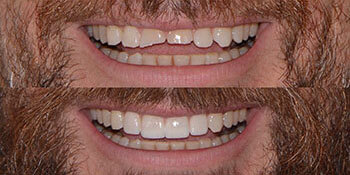Teeth
Dental Procedures Explained - Teeth
An average adult has 32 teeth, while children have 20. The health of teeth and gums is extremely important to a person’s overall health. When a tooth has a cavity (a.k.a. dental caries, tooth decay), the cavitation or decay is caused by acid erosion. This is the by-product from bacteria digesting residual foods in the mouth with carbohydrate; such as bread, cereal, soda, juices, and candies. The bacteria, acids, food debris and saliva combine to form plaque which clings to your teeth causing erosion of the enamel (outer layer of tooth) and dentin (inner layer of tooth), this forms a cavity. Once the cavitation invades the inner layer dentin, the progression of cavity will speed up and will not cease until the cavitation is removed. Cavitation progression and erosion of dentin is 7 x faster than enamel. Therefore, it is crucial to have your cavity restored as soon as possible and before it involves the most inner layer, the pulp chamber. Involvement of the pulp chamber (the nerve of the tooth), will require more extensive treatment, such as root canal therapy or extraction.
There are several different ways to do a cavity filling (tooth restoration). Such as, traditional silver amalgam restoration, composite resin restoration (white filling), as well as inlays and onlays. At City Oasis Dental, we provide patients with white composite resin restorations and ceramic inlays and onlays depending on the clinical condition of the teeth in question. On occasion an inlay or onlay is recommended over composite resin when the inlays/onlays will provide better structural integrity for the tooth restoration. At the same time a ceramic inlay/onlay can provide a better longevity and esthetic outcome.
When a tooth requires root canal therapy, a tooth in the back of the jaw (such as molars and premolars) will also require a full coverage crown to protect the tooth and to prevent the risk of fracture. A post and core build up is sometimes needed to provide the root canal treated tooth with more structure support required for the crown placement. Once a tooth receive root canal therapy, the structure of the tooth becomes dry and brittle due to the lack of blood flow, at the same time the overall structure of the tooth weakens as well. Root canal treated teeth without the protective crown have a tendency to fracture vertically, and if this happens, the fractured teeth may have to be removed.
For more information, please see the attached PDF files or ask Dr. Jennifer when you come in for a consultation.
| Teeth Corcerns and Treatments | Size |
|---|---|
| Cracked Fillings (pdf) | 569 Kb |
| Cracked Tooth (pdf) | 546 Kb |
| Discoloured Fillings (pdf) | 118 Kb |
| Discoloured Tooth (pdf) | 111 Kb |
| Loose Tooth (pdf) | 119 Kb |
| Tooth Ache (pdf) | 441 Kb |
| Tooth Decay (pdf) | 486 Kb |
| Tooth Wear (pdf) | 118 Kb |
| Patient Treatment | Size |
|---|---|
| Build Up (pdf) | 123 Kb |
| Inlay Onlay (pdf) | 147 Kb |
| Post and Core (pdf) | 113 Kb |
| Root Canal Treatment (pdf) | 136 Kb |
| Silver Fillings (pdf) | 128 Kb |
| Tooth Coloured Fillings (pdf) | 148 Kb |
| Tooth Extraction Care Instruction (pdf) | 438 Kb |
| Tooth Extraction Information (pdf) | 452 Kb |
| Tooth Supported Bridge (pdf) | 136 Kb |
| Tooth Supported Crown (pdf) | 142 Kb |
© Kois Center. All rights reserved. This material may not be reproduced, displayed, modified or distributed without the prior permission of the copyright holder.

